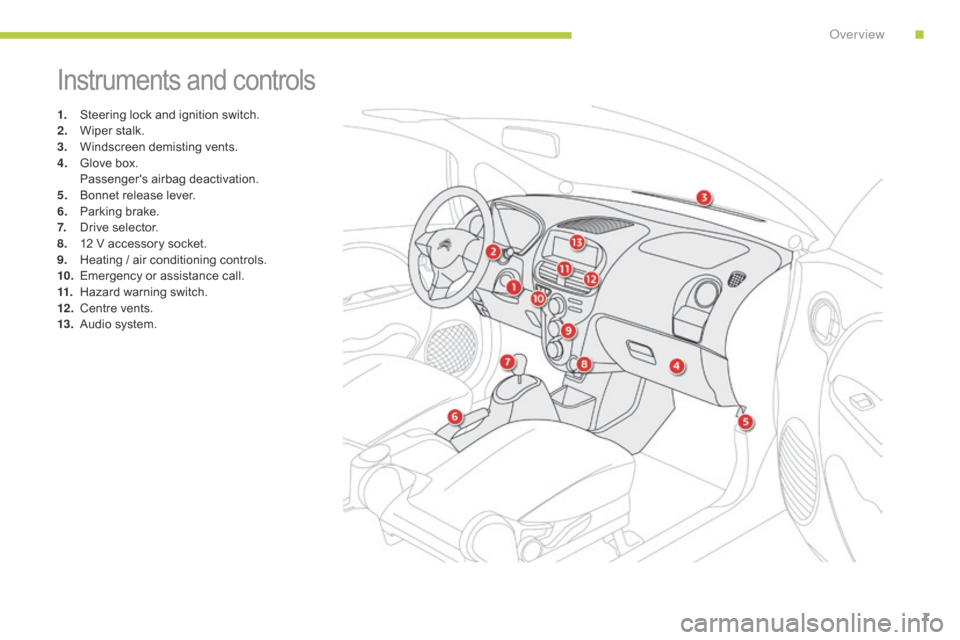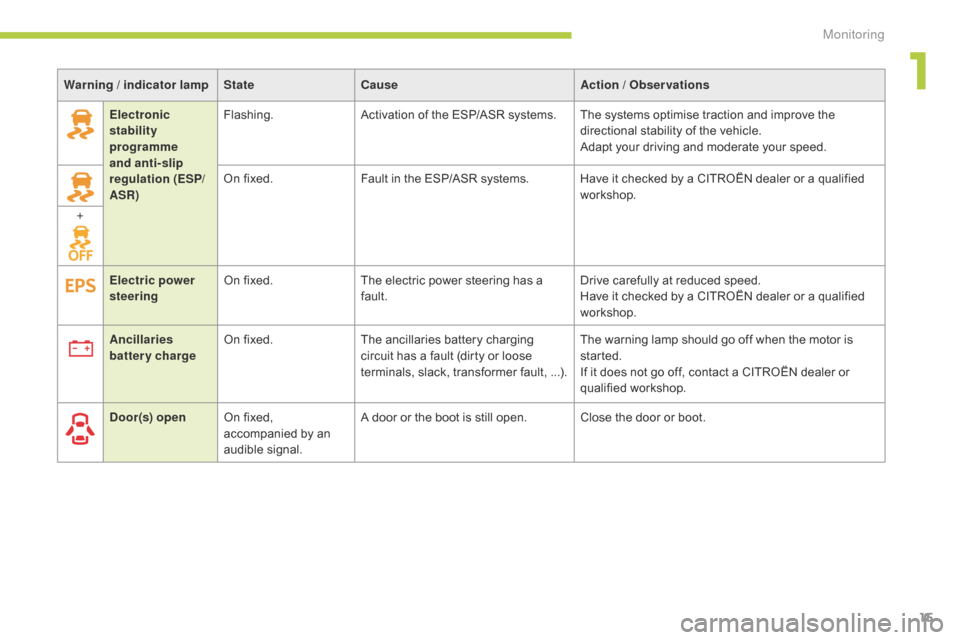steering Citroen C ZERO 2015 1.G Owner's Manual
[x] Cancel search | Manufacturer: CITROEN, Model Year: 2015, Model line: C ZERO, Model: Citroen C ZERO 2015 1.GPages: 176, PDF Size: 5.21 MB
Page 9 of 176

7
C-zero_en_Chap00b_vue-ensemble_ed01-2014
Instruments and controls
1. Steering lock and ignition switch.
2. Wi per stalk.
3.
Wi
ndscreen demisting vents.
4.
Gl
ove box.
Pa
ssenger's airbag deactivation.
5.
Bo
nnet release lever.
6.
Pa
rking brake.
7.
Dr
ive selector.
8.
12 V a
ccessory socket.
9.
He
ating
/ a
ir conditioning controls.
10.
Em
ergency or assistance call.
11.
Ha
zard warning switch.
12 .
Ce
ntre vents.
13.
Au
dio system.
.
Over view
Page 17 of 176

15
C-zero_en_Chap01_controle-de-marche_ed01-2014
Electronic
stability
programme
and anti-slip
regulation (ESP/
ASR)Flashing.
Activation of the ESP/ASR systems. The systems optimise traction and improve the
directional stability of the vehicle.
Adapt your driving and moderate your speed.
On fixed. Fault in the ESP/ASR systems. Have it checked by a CITROËN dealer or a qualified
workshop.
+
Door(s) open On fixed,
accompanied by an
audible signal. A door or the boot is still open. Close the door or boot.
Ancillaries
battery charge
On fixed.
The ancillaries battery charging
circuit has a fault (dirty or loose
terminals, slack, transformer fault, ...). The warning lamp should go off when the motor is
started.
If it does not go off, contact a CITROËN dealer or
qualified workshop.
Electric power
steering
On fixed.
The electric power steering has a
fault. Drive carefully at reduced speed.
Have it checked by a CITROËN dealer or a qualified
workshop.
Warning
/
indicator lamp
State Cause Action
/
Observations
1
Monitoring
Page 49 of 176

47
C-zero_en_Chap04_conduite_ed01-2014
Starting - stopping the vehicle
- Position 1: LOCK The steering is locked.
-
Po
sition 2: ACC
Th
e ancillaries (radio, 12 V socket...) can
be used.
-
Po
sition 3: ON
Ig
nition on.
-
Po
sition 4: S TA R T
"R
eady" lamp on.
Mo
tor ready to drive the vehicle.
Ignition switch
F Check that the drive selector is in
position P.
F In
sert the key in the ignition switch.
F
Tu
rn the key to position 4 (S TA R T ) .
Starting Stopping
F Stop the vehicle.
F Ke ep your foot on the brake pedal.
F
Pl
ace the drive selector in position P .
F
Ap
ply the parking brake.
F
Tu
rn the key to position 1 (LOCK) .
F
Re
move the key from the ignition switch.
F
Ho
ld it in this position for a few
seconds until the " RE ADY " lamp
comes on accompanied by an
audible signal.
F
Re
lease the key.
Th
e key returns automatically to position 3
(ON) . Do not attach any heavy objects to the
key as this could weigh down on it when
in the ignition switch and cause a fault.
If you use the ancillaries for a prolonged
period (with the key in the ACC position),
you risk discharging the ancillaries
battery. Starting your vehicle will then no
longer be possible. Be aware .
4
Driving
Page 59 of 176

57
C-zero_en_Chap06_securite_ed01-2014
Emergency or
assistance call
This system allows you to make an emergency
or assistance call to the emergency services or
to the dedicated CITROËN service.
For more information on the use of this
function, refer to the "Audio and telematics"
section.
Horn
F Press the central part of the steering
wheel.
6
Safety
Page 61 of 176

59
C-zero_en_Chap06_securite_ed01-2014
Under-inflation alert
The alert is given by the fixed
illumination of this warning lamp.
F
Re
duce speed, avoid sudden steering
movements or harsh brake applications.
F
St
op as soon as it is safe to do so.
Before reinitialising the system, ensure
that the pressures in the four tyres are
suitable for the conditions of use of the
vehicle and as specified on the tyre
pressure label.
The under-inflation detection system
cannot warn of an incorrect pressure at
the time of reinitialisation.
The loss of pressure detected does not
always lead to visible deformation of the
tyre. Do not rely on just a visual check.
The alert is maintained until the
reference pressure is reinitialised after
the inflation, repair or replacement of
the tyres concerned. In the event of
the repair or replacement of tyres, the
sensor identifiers must be registered in
the system by a CITROËN dealer or a
qualified workshop.
F Ch
eck the four tyre pressures when cold,
using the compressor from the temporary
puncture repair kit.
If i
t is not possible to check the tyre
pressures at the time, drive carefully at
reduced speed.
or
F In t
he event of a puncture, use the
temporary puncture repair kit.
Reinitialising the reference
pressure
The system must be reinitialised after any
adjustment of tyre pressures and after
changing one or more wheels.
6
Safety
Page 70 of 176

68
C-zero_en_Chap06_securite_ed01-2014
Airbags
The airbags have been designed to contribute
towards improving the safety of the occupants
in the event of violent collisions. They
supplement the action of the force-limiting seat
belts.
In this case, the electronic detectors record and
analyse the front and side impacts suffered in
the impact detection zones:
-
in t
he event of a serious impact, the
airbags are deployed instantaneously
and contribute towards protecting the
occupants of the vehicle; immediately after
the impact, the airbags deflate rapidly
so that they do not hinder the visibility of
the occupants or their possible exit from
the
v
ehicle,
-
in t
he event of a minor impact or rear
impact and in certain roll-over conditions,
the airbags may not be deployed; the seat
belt alone contributes towards providing
your protection in these situations.
The airbags do not operate when the
ignition is off.
This equipment only operates once. If a
second impact occurs (during the same
or a subsequent accident), the airbag
will not be deployed again. The deployment of one or more airbags
is accompanied by a slight discharge
of smoke and a noise, due to the
activation of the pyrotechnic cartridge
incorporated in the system.
This smoke is not harmful, but sensitive
individuals may experience some
irritation.
The noise of the detonation related to
the deployment of one or more airbags
may result in a slight loss of hearing for
a short time.
Impact detection zones
A. Front impact zone.
B. Si de impact zone.
Front airbags
Deployment
The airbags are deployed, except the
passenger's front airbag if it is deactivated,
in the event of a serious front impact applied
to all or part of the front impact zone A , in
the longitudinal centreline of the vehicle on a
horizontal plane and directed from the front to
the rear of the vehicle.
The front airbag inflates between the front
occupant of the vehicle and the dashboard to
cushion their for ward movement. System which protects the head and chest of
the driver and front passenger in the event of a
front impact.
The driver's airbag is fitted in the centre of the
steering wheel; the front passenger's airbag is
fitted in the dashboard above the glove box.
Safety
Page 73 of 176

71
C-zero_en_Chap06_securite_ed01-2014
Sit in a normal upright position.
Wear a correctly adjusted seat belt.
Do not leave anything between the
occupants and the airbags (a child, pet,
object...). This could hamper the operation of
the airbags or injure the occupants.
After an accident or if the vehicle has been
stolen or broken into, have the airbag
systems checked.
All work on the airbag system must be
carried out by a CITROËN dealer or a
qualified workshop.
Even if all of the precautions mentioned
are observed, a risk of injury or of minor
burns to the head, chest or arms when an
airbag is deployed cannot be ruled out. The
bag inflates almost instantly (within a few
milliseconds) then deflates within the same
time discharging the hot gas via openings
provided for this purpose.Lateral airbags
Use only approved covers on the seats,
compatible with the deployment the lateral
airbags. For information on the range of seat
covers suitable for your vehicle, you can
contact a CITROËN
d
ealer.
Refer to the "Accessories" section.
Do not fix or attach anything to the seat
backs (clothing...). This could cause injury
to the chest or arms if the lateral airbag is
deployed.
Do not sit with the upper part of the body any
nearer to the door than necessary.
Front airbags
Do not drive holding the steering wheel by its
spokes or resting your hands on the centre
part of the wheel.
Passengers must not place their feet on the
dashboard.
Do not smoke as deployment of the airbags
can cause burns or the risk of injury from a
cigarette or pipe.
Never remove or pierce the steering wheel or
hit it violently.
Do not fit or attach anything to the steering
wheel or dashboard, this could cause
injuries with deployment of the airbags.
For the airbags to be fully effective, observe the following safety rules:
Curtain airbags
Do not fix or attach anything to the roof. This
could cause injury to the head if the curtain
airbag is deployed.
If fitted on your vehicle, do not remove the
grab handles installed on the roof, they play
a part in securing the curtain airbags.
6
Safety
Page 100 of 176

98
C-zero_en_Chap08_info-pratiques_ed01-2014
1. 12 V compressor with integral pressure gauge, to measure and adjust the tyre
pressure.
Composition of the kit
2. Sealant cartridge for the temporary repair
o f a tyre.
3.
In
jection pipe.
4.
Su
ction pipe, to remove the sealant product
if necessary.
5.
Sa
chet containing a replacement valve
core, a tool for removing/refitting the valve
core and a speed restriction sticker.
The speed restriction sticker must be
affixed to the vehicle's steering wheel to
remind you that a wheel is in temporary
use.
Do not exceed a speed of 50
m
ph
(80
k
m/h) when driving with a tyre
repaired using this type of kit.
Refitting the rear seat cushion
F Put the metal cover back into place.
F Re fit the four "butter fly" screws.
F
In
sert the metal hooks into the seat
backrest.
F
Fo
ld the seat cushion down until it locks in
place.
When refitting the cushion, take care
not to trap the seat belt buckles.
Practical information
Page 101 of 176

99
C-zero_en_Chap08_info-pratiques_ed01-2014
Repair procedure
1. Sealing
F Switch off the ignition.
F In dicate on the speed restriction sticker
provided, the wheel to be repaired, then fix
it to the steering wheel as a reminder that a
wheel is in temporary use.
F
Sh
ake the sealant cartridge, remove the
cap and screw on the injection pipe. F
Re
move the valve cap for the tyre to be
repaired.
F Re move the valve core using the tool
provided, and store in in a clean place.
F
Co
nnect the injection pipe to the valve of
the tyre to be repaired. F
Ta
p the sealant cartridge (top down)
several times with your hand, so as to
inject all of the product into the tyre.
F
Re
move the injection pipe.
F
Re
fit the valve core and tighten it using the
tool provided.
Take care, this product is harmful (e.g. ethylene-glycol, colophony...) if swallowed and
causes irritation to the eyes.
Keep it out of reach of children.
The use-by date of the sealant is marked on the cartridge.
After use, do not discard the empty cartridge but take it to a CITROËN dealer (France) or an
authorised waste disposal site.
Don't forget to obtain a replacement cartridge; they are available from a CITROËN dealer or
a qualified workshop.
Avoid removing any foreign bodies
which have penetrated into the tyre.
8
Practical information